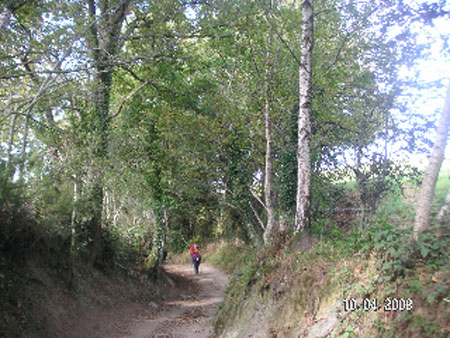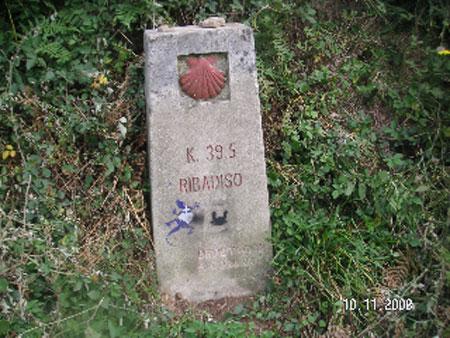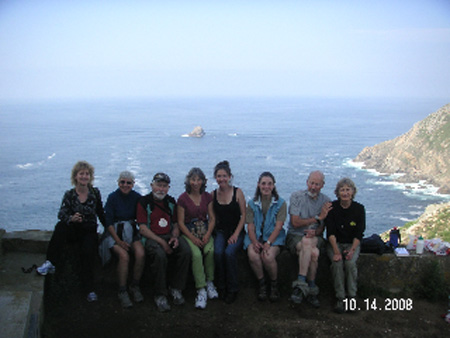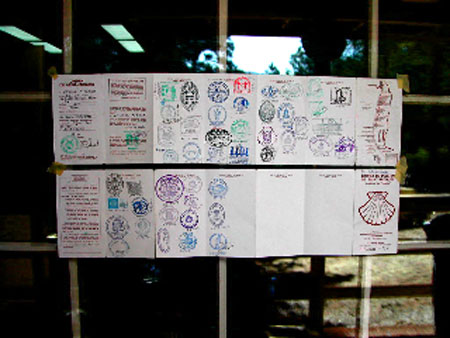Author:
Yvonne Keller
Trip Leaders:
Dick and Judy Opsahl
Participants: Marilyn
Yeamans, Sara Maxwell (Marilyn's daughter), Karen Grace, Joy Green,
and Chick & Yvonne Keller, and Dick & Judy Opsahl.
We
have been back from Spain for almost 3 weeks now and yet we are
still under the spell of the Camino. On October 1, 2008 eight of us
began walking the Camino to Santiago de Compostella from the small
city of Ponferrada in northwestern Spain. We carried lightweight
backpacks with a change of clothing, a pair of sandals, a sleeping
bag, rain gear, water bottle, a little food, our pilgrim passports
and our journals. We walked 10 or 11 kilometers on our shortest day
and about 30 on the longest. Everyone seemed to fall right into the
daily routine of the 'peregrino', the pilgrim--up at 6:00 a.m. to
dress in the dark, stuff the sleeping bag, pack up, and then to the
kitchen of the albergue, the pilgrim hostel, to have a little
breakfast. Then out the door by 7:30 or 7:45 to start walking in the
dark.

A wooded section
passing through farmland midway in Galicia.
We
walked through countryside full of vineyards on our first day. The
grapes were ripe and pickers offered us bunches of delicious purple
grapes as well as green grapes. On other days we snacked on small
sweet blackberries growing along the path. We walked through shady
oak woods and chestnut groves, by cornfields and tree farms, through
green hills with grazing cows, across creeks, and through tiny
villages of stone houses with slate roofs. It was a pleasure to go
through the countryside and villages on foot rather than by car, bus
or train.

Trail marker along the
route. For the last 100 kilometers
to Santiago, there is a marker every 1/2 k.
Along the way and in the cafés of the villages and towns and in the
albergues we met other pilgrims. The Camino is a veritable United
Nations afoot. We met pilgrims from Italy, Germany, Ireland, France,
South Africa, England, Korea, New Zealand, Australia, Brazil,
Argentina, Canada. Everyone knew at least two words of Spanish--"Buen
camino" (have a good walk). And we all seemed to be able to
communicate with each other no matter what our native language. And
we all had something in common of course--walking the Camino--and
all which that requires--nursing blisters, washing your change of
clothes, finding a little 'mercado' (market) to buy some bread and
cheese for lunch. The camaraderie among the pilgrims was a
highlight. Still, although we slept in bunk beds in dormitory-style
rooms in most of the albergues and bathrooms and showers were
sometimes co-ed, I was impressed by how, even in a crowded and
confined space, people could somehow give each other a sense of
privacy.

Here we are at
Finnisterre, the "end of the earth",
after the completion of our pilgrimage.
The
medieval pilgrim's goal in walking the Camino was to reach the
Cathedral of Santiago de Compostela and earn indulgences. Even today
some pilgrims do it for religious or spiritual reasons. Others are
after the physical challenge of walking daily for weeks or to enjoy
the opportunity of meeting people from many countries. Some may want
to have the different touristic experience of northern Spain and
southwestern France. And some may want to experience a part of
medieval European history, or might want to visit the small
Romanesque churches and the Gothic cathedrals on foot as medieval
pilgrims did. It was interesting that people did not generally bring
up the subject of why they had decided to walk the Camino and did
not ask others why they were doing it. This seemed to fit in with
the respect for each other's privacy that pilgrims seem to have.
Whatever the reasons the eight of us who went to Santiago might have
had for doing it, we all came home glad that we went.

Pilgrim passports on
display.
We
got the Pilgrim passports stamped and dated at each hostel or church
along the way. We all had these to show to the office of the
catholic church at the end as proof that we had earned our
completion document called a "compostella".